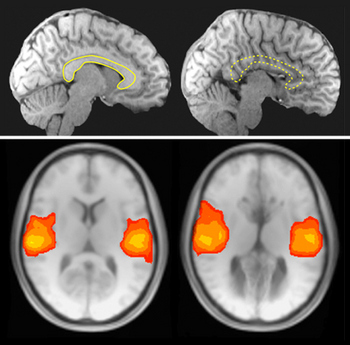A key point here is that this occurs (so far) only in those who are born without the corpus callosum intact (agenesis of the corpus callosum, or AgCC) and not in those who have the corpus callosum severed due to epilepsy or other conditions. During fetal development, the brain appears to reorganize around alternative methods of communication between hemispheres.
Unexplained communication between brain hemispheres without corpus callosum
October 21, 2011 by Editor
Magnetic resonance images comparing a healthy subject (left) with an AgCC patient (right). The corpus callosum is the thick, c-shaped structure outlined in the healthy brain and missing from the AgCC brain. Bottom image: Functional magnetic resonance images highlight symmetric patterns of synchronized activity in both healthy (left) and AgCC subjects (right) during rest with eyes closed. More than 15 of this type of network were found to be preserved in AgCC subjects. (Credit: California Institute of Technology)Could the brain be using electromagnetic fields to communicate between hemispheres — theelectromagnetic field theory of consciousness proposed by Johnjoe McFadden (School of Biomedical and Life Sciences, University of Surrey)?Neuroscientists at the California Institute of Technology(Caltech) have made a puzzling finding: people born without a corpus callosum (which links the two hemispheres of the brain) — a condition called agenesis of the corpus callosum, or AgCC — still show remarkably normal communication across the gap between the two halves of their brains.According to J. Michael Tyszka, associate director of the Caltech Brain Imaging Center, many areas of the brain display slowly varying patterns of activity that are similar to one another. The fact that these areas are synchronized has led many scientists to presume that they are all part of an interconnected network called a resting-state network.Neuroscientists baffledMuch to their surprise, Tyszka and his team found that these resting-state networks look essentially normal in people with AgCC, despite the lack of connectivity.“This was a real surprise,” says Tyszka. “We expected to see a lot less coupling between the left and right brain in this group — after all, they are missing about 200 million connections that would normally be there. How do they manage to have normal communication between the left and right sides of the brain without the corpus callosum?”AgCC occurs in approximately one of every 4000 live births. The typical corpus callosum comprises almost 200 million axons — the connections between brain cells — and is the largest fiber bundle in the human brain. In AgCC, those fibers fail to cross the gap between the hemispheres during fetal development, forcing the two halves of the brain to communicate using more indirect — and currently unknown — means.According to the team, the findings are especially valuable in light of current theories that link impaired brain connections with clinical conditions including autism and schizophrenia.“We are now examining AgCC subjects who are also on the autism spectrum, in order to gain insights about the role of brain connectivity in autism, as well as in healthy social interactions,” says Tyszka. “About a third of people with AgCC also have autism, and altered connectivity in the corpus callosum has been found in autism. The remarkable compensation in brain functional networks that we found here may thus have important implications also for understanding the function of the brains of people with autism.”Citation:
Ref.: J. Michael Tyszka, et al., Intact Bilateral Resting-State Networks in the Absence of the Corpus Callosum, The Journal of Neuroscience, 2011; [DOI:10.1523/JNEUROSCI.1453-11.2011]

No comments:
Post a Comment